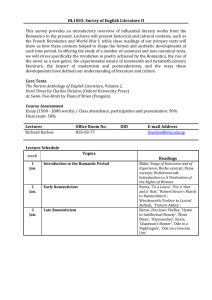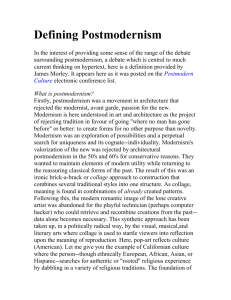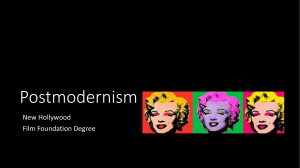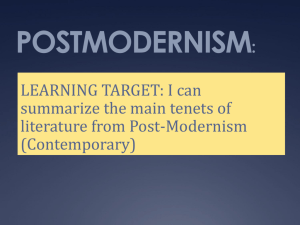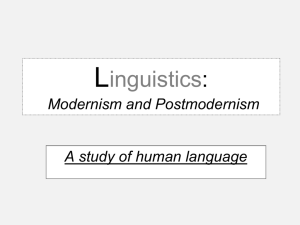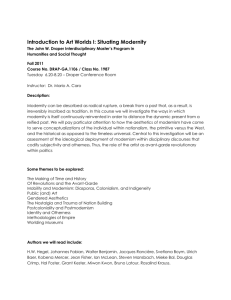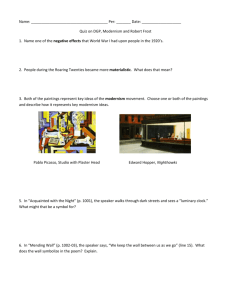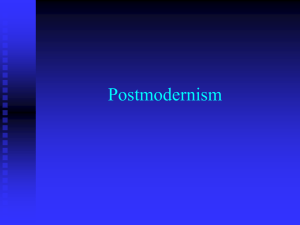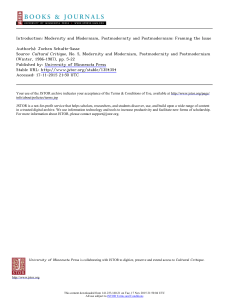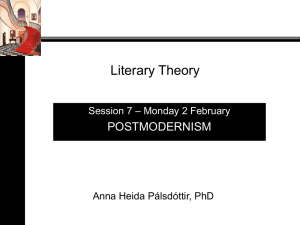Have we really moved beyond Modernism?
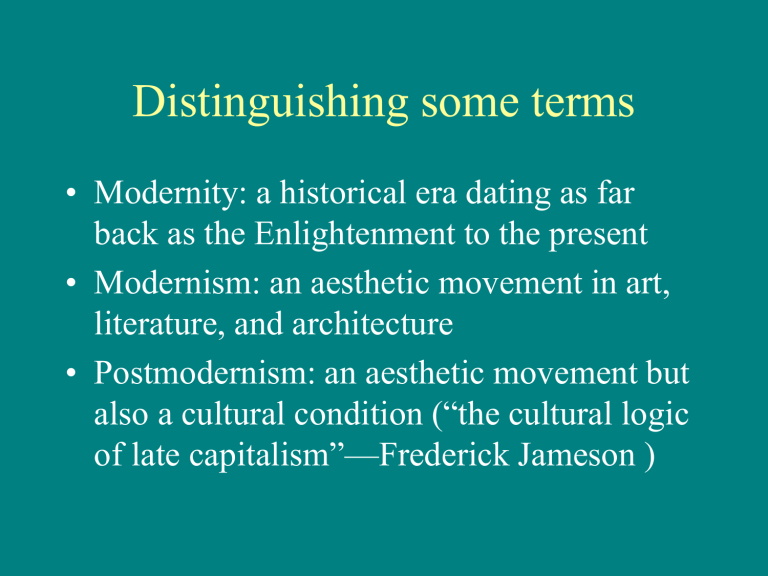
Distinguishing some terms
• Modernity: a historical era dating as far back as the Enlightenment to the present
• Modernism: an aesthetic movement in art, literature, and architecture
• Postmodernism: an aesthetic movement but also a cultural condition (“the cultural logic of late capitalism”—Frederick Jameson )
Modernism
• Belief in humanism: order, rationality and science are human constructs that solve social problems.
• Universality: the articulation and advancement of human freedom is a worldwide project… even if it proceeds through the West.
Modernist housing
Architects seeks to bring the benefits of scientific research on sanitation, comfort, and aesthetics to the humblest of homes through their interpretations of what the basic requirements for living were.
Modernism:
Industrialism as aesthetic
• The efficient machine provides function as well as form.
• Industrialism offers an
“authentic” symbolic system from which artists and architects draw.
Modernism:
Formalism as aesthetic
• Emphasizing geometrical design and basic colors: the
“unadorned cube as aesthetic model.”
• Designs that can go anywhere: privileges the individual’s visual and mental capacity, ignores social and environmental contexts.
Modernism:
History as Grand Narrative
• The ultimate story: human civilization advances over time.
• Essentialism: History privileged as the universal narrative of human
“becoming.”
• Geography and environmental context debased as leftovers of particularity and difference.
Have we really transcended
Modernism?
• The existence of Postmodernism is hotly debated.
• Many social theorists contend that so-called postmodernism is really just the latest stage of
Modernism (“Late Modernity,” “Reflexive
Modernity,” etc.)
• Postmodernists rebut that the very unevenness of a cultural condition (Modernism and
Postmodernism and even Pre-Modernism) characterizes the Postmodern condition.
Postmodernism:
The decentered subject
• Literally a problem of
“identity”: following Freud, we do not really know ourselves.
• The singular and unified identity of the humanist subject is rejected in favor of a narrative space that is pluralized and fluid.
• The decentered collectivity: who is the “community”?
Who are “we”?
The Bonaventure Hotel
There are three entrances to the Bonaventure, one from Figueroa and the other two by way of elevated gardens on the other side of the hotel, which is built into the remaining slope of the former
Bunker Hill. None of these is anything like the old hotel marquee, or the monumental porte cochere with which the sumptuous buildings of yesteryear were wont to stage your passage from city street to the interior. The entryways of the Bonaventure are, as it were, lateral and rather backdoor affairs: the gardens in the back admit you to the sixth floor of the towers, and even there you must walk down one flight to find the elevator by which you gain access to the lobby. Meanwhile, what one is still tempted to think of as the front entry, on Figueroa, admits you, baggage and all, onto the second story shopping balcony, from which you must take an escalator down to the main registration desk. What I first want to suggest about these curiously unmarked ways in is that they seem to have been imposed by some new category of closure governing the inner space of the hotel itself… The Bonaventure, however, is content to "let the fallen city fabric continue to be in its being" (to parody Heidegger); no further effects, no larger protopolitical Utopian transformation, is either expected or desired.
—Frederick Jameson
The end of the Grand Narrative
• The Enlightenment, science, Marxism and other modern theoretical systems have understood history as a linear process moving the West progressively toward a final realization of freedom.
• Postmodernism rejects these totalizing systems for reducing history to essentially a single Grand
Narrative.
• History need not move forward. It can go backwards… or in cycles.
Postmodern skepticism
• The Holocaust and the atom bomb shatter faith in human progress and the growth of rationality.
• No claims to universal, objective knowledge are valid. “Truth” ultimately depends on the subject’s perspective(s).
• Critique of Marxism: there is no universal subject to be alienated; there is only schizophrenia.
• Modernists identify questions and seek answers.
Postmodernists trouble and destabilize (if they engage the “big questions” at all).
Rejecting the high/low culture distinction
• The canons of literature, art, and music, are found to reflect the values of particular social groups, not civilization as a whole.
• Popular culture, mass culture, and folk art forms are thus proper objects for study.
• The modernist belief that intellectuals can occupy a critical space outside of capitalist society is not only illusory but also politically and artistically sterile.
Architects go “lowbrow”
Abandoning their elitist grounding in high culture,postmodern architects embrace mass culture for symbolic themes and popular uses.
Postmodernism:
Pastiche as aesthetic
• Amidst constant change, order is not only difficult to construct, but also politically suspect.
• Pastiche reassembles symbols from different systems into idiosyncratic ensembles.
• Whereas the modernist pores through a text from start to finis, the postmodernist cuts up texts as collage (“Pulp
Fiction,” channel surfing).
Gehry House
The disappearance of the Idea that rationality and freedom are progressing would explain a
‘tone,’ style, or mode specific to postmodern architecture. I would say it is a sort of ‘bricolage’: the multiple quotation of elements taken from earlier styles or periods, classical and modern; disregard for the environment; and so on.
—Jean-Francois Lyotard
Depthlessness
The chaos of constant change, the loss of historical temporality, and the fragmented subject give a new emphasis to superficial meanings and frustrate the coherence of deep
(singular) narratives.
Simulacra
• References to
“histories” or other
“real” symbols that in fact never existed.
• In postmodernism, the past is viewed and valued through its simulated recreation, not its reality.
Irony
• The use of language to express something other and especially opposite than the literal meaning.
• The modernist celebrates or laments. The postmodernist smirks, having lost hope in the aesthetic or social advancement that
Modernism believes in.
